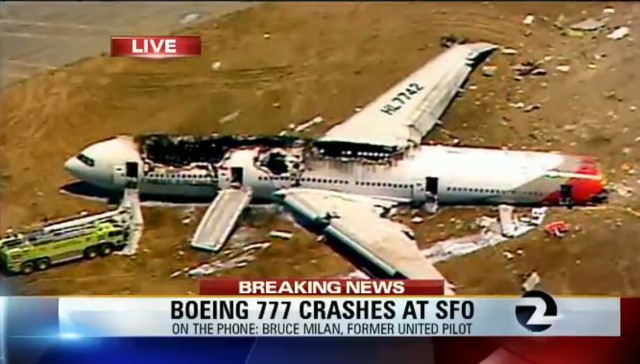
Air shot of the Asiana Airlines Flight 214 crash at SFO via KTVU.
As of 07/06 5:47pm PST, updates will be added to the bottom of the story and the main story will not change.
Just before 11:30am today, an Asiana Airlines Boeing 777-200ER (registration HL7742) coming from Incheon, South Korea, landed before the runway at San Francisco International Airport (SFO) causing the aircraft to break up. Passengers were evacuated before the aircraft caught fire. There were 291 passengers (19 business and 272 economy) and 16 crew on the aircraft. According to Asiana Airlines, the passengers, “were comprised of 77 Korean citizens, 141 Chinese citizens, 61 US citizens, 1 Japanese citizen.”
Photos show debris before runway 28, showing that the aircraft hit the ground before making it over the runway. At about 1:15pm, local San Francisco TV station, KTVU stated that two passengers died and at about 4:15pm, the SF Fire Department confirmed those deaths.
San Francisco General Hospital spoke at about 3:15pm PST and stated that they have received 10 patients in critical condition. As of 5:45pm five of those passengers improved their condition. Out of 307 passengers on board, 181 were taken to multiple hospitals. According to the SF Fire Department, there were a total of 230 passengers who has some sort of injury after the crash. Originally there were 60 passengers who were reported missing, but as of 5:45pm there is only one.
Typically with situations like this, death/injury numbers will often change.
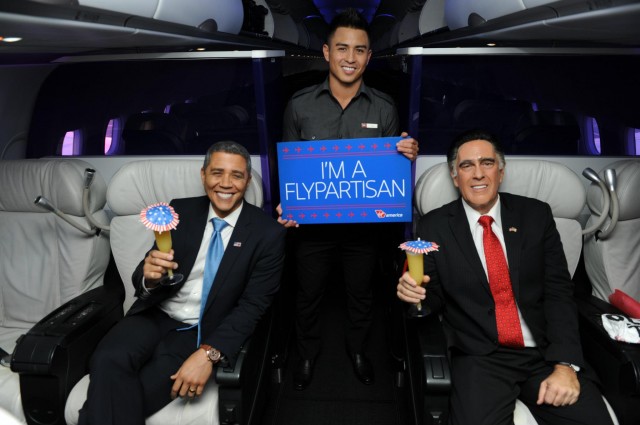
Whoa, Virgin American got President Obama and Romney (impersonators) to join in on the flight. Image from Virgin America.
When most airlines start a new route, they might send out a boring press release to announce it to the world, but not Virgin America. The airline has a history of making a party out of each of their new destinations and their new route from San Fransisco (SFO) to Ronald Reagan Washington National Airport (DCA) is no different.
Sure, Virgin America has been flying into DC for a while, but only to Dulles International Airport (IAD), not DCA.
Previously, there were no direct flights from SFO to DCA via any airline, due to restrictions on destinations more than 1,250 miles away. The recent FAA Modernization and Reform Act of 2012 (click that link if you want 300 pages of amazing reading), authorized the DOT to award a limited number of new flights to domestic airports located farther away. In May, United Airlines started flying the route non-stop and now Virgin America is the only other competition.
So what gimmick was Virgin American going to have for this inaugural? They had Always Sunny in Philadelphia for their PHL flight, Rat Pack for Palm Springs, Boxing with Chicago and just plain awesome with Toronto — which is no longer an active route for the airline. This is an election year and the flight is going to DC, so why not involve politics? The airline had presidential impersonators Jim Gossett as ’œMitt’ and Reggie Brown as ’œBarack’ on the flight.
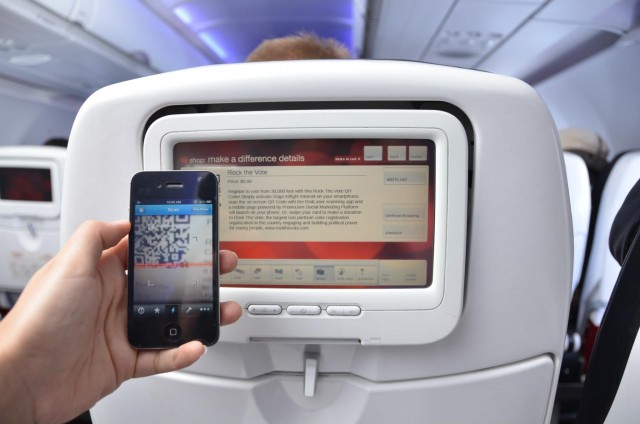
Use your smart phone to scan the QR code on RED and register to vote. Image from Virgin America.
This trip was not just a party, but also an effort to get more people registered to vote. Virgin America has partnered with Rock the Vote and passengers are able to register to vote using the airline’s in-flight entertainment system and their smart phones.
“We the people get to decide who will be flying to DC next year as our representatives, but no matter who you are voting for this November, you have to be registered first,’ said Heather Smith, President of Rock The Vote. ’œRock the Vote is thrilled to bring voter registration to Virgin America’s guests as well as the opportunity to make a donation to support our efforts to register 1.5 million new voters and educate young Americans about participating in our democracy.”
Virgin America currently serves 18 destinations, a fleet of 52 Airbus A320-family aircraft and over 2,600 employees.
SEE MORE PHOTOS OF THE INAUGURAL FLIGHT ON VIRGIN AMERICA’S FACEBOOK
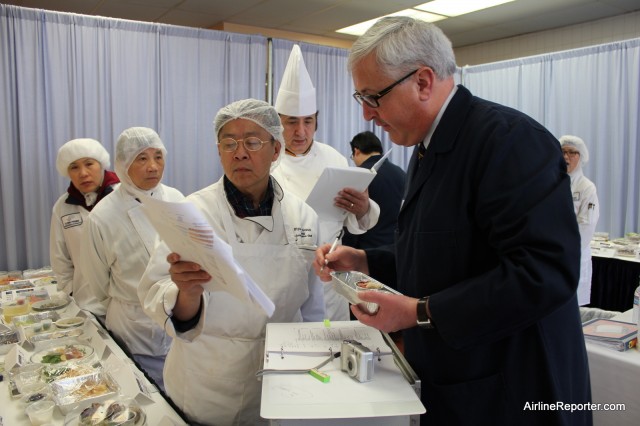
Singapore Airlines goes item by item checking the food quality at the Flying Food Group at SFO.
When it comes to airline food, most people have a pretty low expectation of what they will receive. That expectation has lowered even further over the past few years with the almost-complete elimination of free airline food served on domestic flights within the United States. To find a decent airline meal, one needs to take an international flight. Typically, the amount you pay for a ticket will correlate with the level of meal you will receive. How does a world class airline go about providing multiple meals for up to 477 passengers on just one flight? I wasn’t sure, but when I was recently given the opportunity to check out how Singapore Airlines runs its food operation out of San Francisco (SFO), I could not refuse (note that my trip down and back were taken care of by Singapore Airlines and JetSuite).
Checking out Singapore Airlines makes sense. For them, food is not just something they give to passengers to make sure they don’t go hungry; they see it as part of the in-flight service. It is an experience both via taste/sight and a positive interaction with the flight crew. How does an airline prepare a meal for someone who has spent $5000.00 or even $20,000.00 on a ticket and are used to the best things in life? Well, it is not easy, nor cheap. Each year, Singapore Airlines spends about $500,000,000.00 just on their food service alone — that is quite the investment.
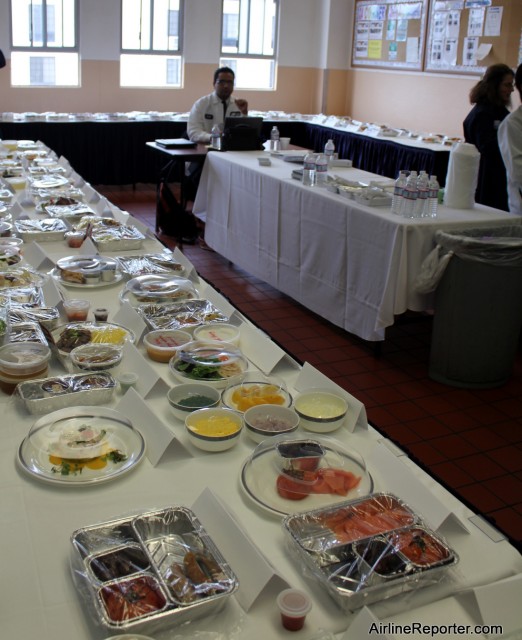
The room has food all around from first, business and economy levels of service.
At each main Singapore Airlines hub in the US, it selects a caterer to produce the food. At SFO, it uses Flying Food Group, which also provides airline catering for a number of other airlines, even though all of Singapore’s recipes are unique.
Frequent fliers on Singapore do not want to see the same food week after week, so the airline needs to keep the selection new. Because of this, Singapore Airlines changes most of its entire menu each quarter. Hidden away in Singapore Airlines headquarters is a list of all the food that will be served in the coming quarters. The menu is not just a broad, “we will serve chicken and salad,” but a list that is extremely detailed, down to the exact last gram of everything, how many nuts will be on that salad and how much the entire meal will weigh.
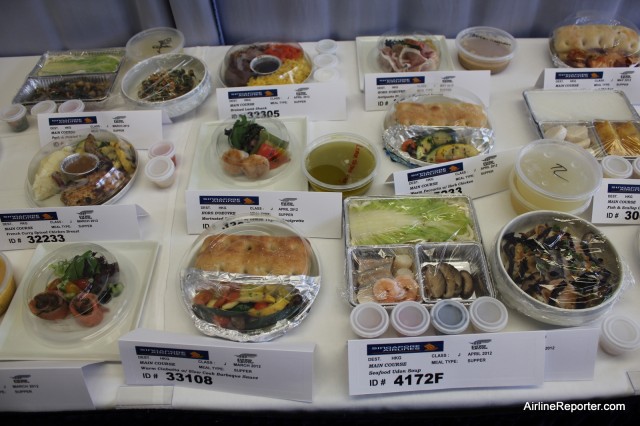
The Singapore food tasters need to come in hungry, since they will be leaving full.
There is no down time when it comes to the food. Just after the previous quarter’s food goes live, Singapore sends the next quarter’s menu to the Flying Food Group, so that they can start preparations for following quarter. Their chefs work on successfully creating the new menu and once they have all the food from each of the three classes completed, they invite Singapore Airlines in for a Menu Presentation to visually inspect each and every item and then taste test the food — this is where my visit comes in.
After landing at SFO, I was driven to the Flying Food Group building, located just down the street from the airport. The building is not the most beautiful on the outside, but it is more about what is on the inside. After being checked in, I put on an official food tester garb and was taken to a back room, which had hundreds of different food options on display. Representatives from both the Flying Air Group and Singapore Airlines went item by item, going over every aspect of each main dish, side dish, sauces and the plate layout.
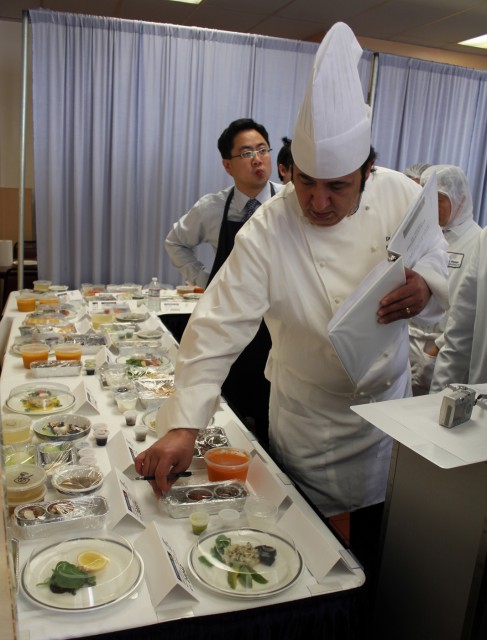
The chef shows off his creations.
Once the food is agreed upon, photos are taken that will be placed on the aircraft, so that flight attendants will know what the final serving should look like. But before anything can be finalized, the food needs to be tasted. It is a rough life, but to be able to write the best story possible, I decided I should probably try some of the food.
We were escorted to another room, where samples of the food were being served. From the soups to salads, to main entrees, I have to say that they were good — really good. During the sampling it was determined that one of the soups was a bit too spicy and Singapore requested that it be toned down a bit and the caterer agreed.
Making quality food at a restaurant on the ground is difficult enough as it is. Creating a meal, that will not be eaten for another ten hours and it still needs to taste world class is a whole other level. One question is how much should the caterer cook the food vs how much does it get cooked on the plane? For example, chicken will be cooked about 60% on the ground and the rest in the air, where steak will only be cooked 30% before being loaded onto a plane.
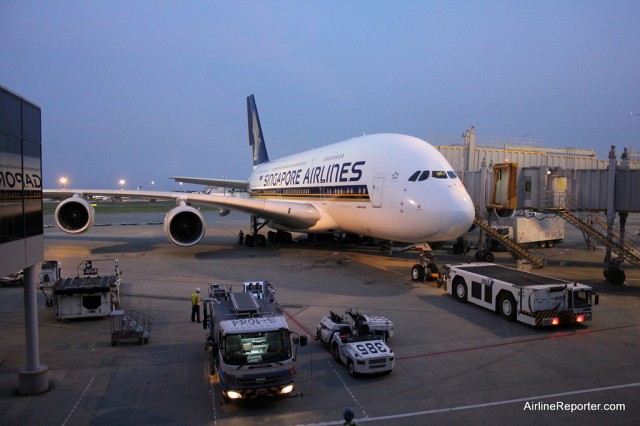
Singapore Airlines Airbus A380 can hold 471 people. Times that by multiple meals and things can get challenging. This A380 is seen waiting at Narita in Tokyo.
No matter what level the food is cooked, once it is ready, it is “blast chilled.” Now, do not call this “freezing” the food — I got the feeling that calling it that is borderline insulting. In the blast-chilled process, the food is taken to just above freezing very quickly, but doesn’t cause all the damage at the cellular level that freezing does. The food is then loaded onto carts, then to a truck, then off to the airport to be loaded onto the aircraft. It is an impressive ballet of trying to time things just right so the food does not go too long before being consumed.
Delays in the airline business are inevitable. While passengers begin to stress about arriving late, there are people who are thinking about the food. If a delay pops up early enough, the food’s preparation is held off until later. If the food is already made, it will be stored in a freezer at the caterer. The worse case scenario, if a flight is delayed after the food has already been loaded onto the aircraft, there are times, where the call is made to dump the current food and have the caterer bring over a fresh supply. It is a costly waste, but better than passengers getting sub-par food or worse, sick.
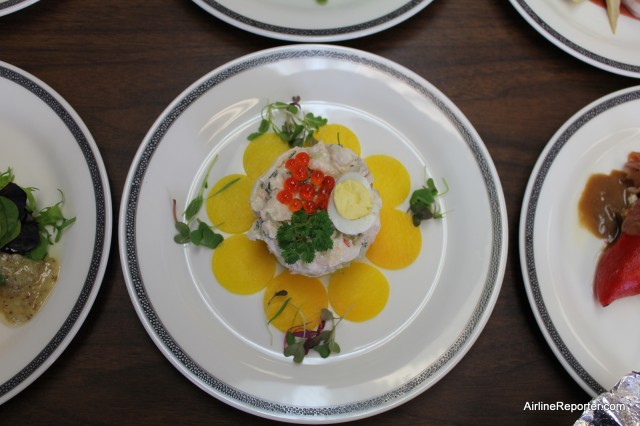
Lobster, quail eggs and caviar make for an impressive meal.
It is difficult, but having to destroy food is part of the airline catering business. At the end of each flight, there will always be left over food. Either from passengers who didn’t finish their entire meal or for whole carts of food that were never used. Due to international regulations, all food that returns to the US on an international flight needs to be destroyed. The carts are loaded back onto the caterer’s trucks, taken to the facility and placed into a huge oven before being disposed of. This is to assure that there are no food-borne bugs that could cause an international incident.
Serving the same quality of food in economy as you do in first class could also cause some sort of incident — folks who pay more, expect a higher level of food. First class meals are prepared using three different types of ovens: steam, convection and microwave. Each item is individually cooked before being served to the customer. Economy food is made to be more efficient and less time consuming. If you order scramble eggs as a First Class passenger, they will break open real eggs while in-flight and prepare them right there on the plane for you. However, if you are seated more towards the back, you are getting pre-prepared eggs from the ground.
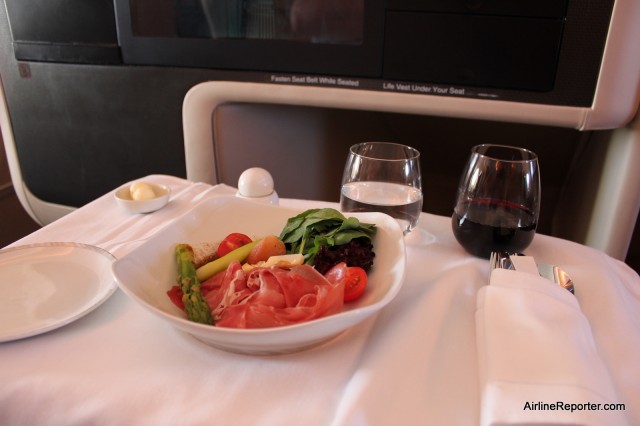
And then, the meal ends up on the plane. This photo is from 2010 on Singapore Airlines A380 Business Class.
What amazed me the most about this was how much process, time, energy and money is involved to get food to passengers. The crazy thing is this is only for SFO flights, (there are only three: Seoul, Hong Kong and Singapore) and each of these steps are repeated around the world.
If you get bored of the Singapore menu before the quarter runs out, you also have the options Book the Cook program, which allows you to order a custom meal.
I have had the opportunity to fly on Singapore Airlines A380 previously, and I had no idea the work and preparation that went into my food. Airline food might never be the same for me. I am always going to think about how the meal was planned, cooked and the detailed process it experienced before reaching my palate.
View all 23 photos from the Singapore Menu Presentation
JETSUITE REVIEW BASICS:
Airline: Not an airline… try JetSuite private jet.
Aircraft: Embraer Phenom 100
Departed: Boeing Field (BFI)
Arrived: San Fransisco International Airport (SFO)
Stops: Non-stop flight
Class: Uber private jet class
Seat: Yes. Window and Aisle
Length: About 2.0 hours
Cheers: You are riding in a private jet and get all the bonuses that go along with that.
Jeers: You can only bring three of your friends.
Overall: JetSuite is a cost effective option that makes it difficult to go back to flying commercial.
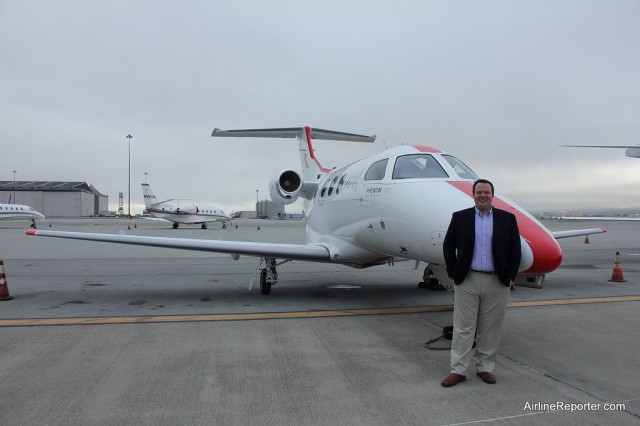
I did not have to fake that smile. On the tarmac at SFO after our JetSuite flight. This is the 100th Phenom made by Embraer, reg number N581JS.
THE FULL JETSUITE REVIEW
When I was recently asked if I might want to hitch a ride from Seattle (BFI) to San Francisco (SFO) on a JetSuite private jet, how could I refuse? I have always wanted to try flying on a private jet and before this, I have never had the opportunity, so I was game.
Aren’t private jets just for the uber rich and was an exclusivity meant for a rare few? I now see that it depends on who you are flying and how flexible your schedule might be. JetSuite is a luxury that even the common man can afford and the better off can still appreciate (note: JetSuite flew me and a photographer down to SFO at no charge and Singapore Airlines paid for our commercial flights home).
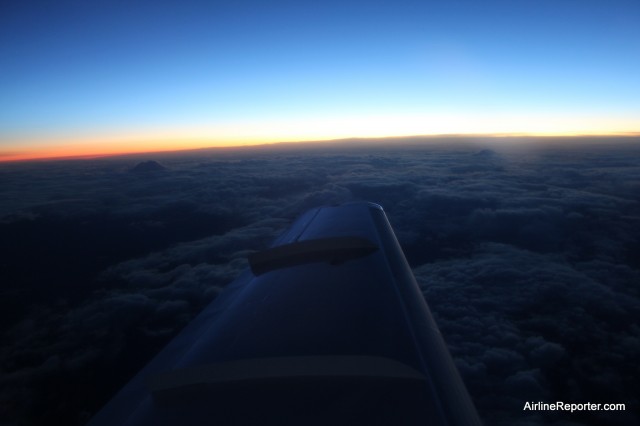
Mount Rainier and Adams popping above the clouds shortly after take off.
My JetSuite flight was scheduled to leave Seattle at around 6:45 am, which meant it was an early morning. It is amazing how knowing you are going to fly can help to wake you up. I was hoping to get photos of the Embraer Phenom 100 aircraft before we departed, but it was dark and (take a wild guess) rainy.
One of the benefits of flying on a private jet is not having to deal with the airport hassle. Most private jet flights leave from an FBO (Fixed Base Operator), which is really a small office for private aircraft. It took me about 3 minutes to get from my car to the aircraft and that was with a stop to get coffee. No security, no lines, no hassles. An extra bonus is I was greeted by our two pilots and we had the opportunity to get to know them a little bit before taking off.
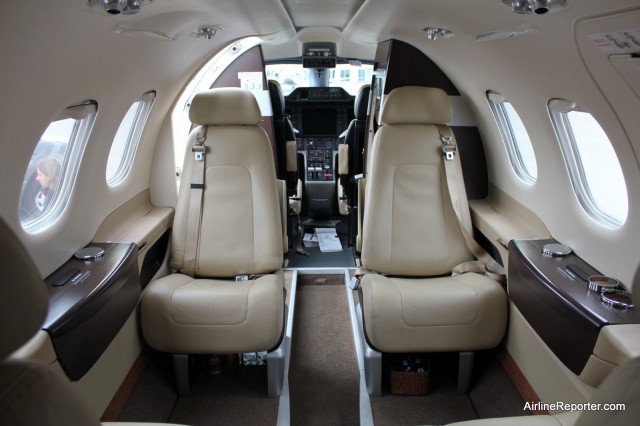
The Phenom 100's interior was designed by BMW and is actually pretty roomy. I took the seat on the right facing backwards.
It was time to go. After a quick run from the FBO to the plane to avoid the rain, I was ready to start our journey. Currently, JetSuite only operates the small Embraer Phenom 100 aircraft that can hold four passengers. You cannot miss them with their red racing stripe going down the center, providing a unique look. It seems that some folks are not a fan of the aggressive livery, but I love it. It gives their aircraft that race car look and isn’t the swirly grays or tans that you normally see on a private jet.
I was not sure what to expect since the Phenom 100 is such a small plane, but looks can be deceiving. I was impressed with how much room was in the cabin and how easy it was to work, take photos and chat with the others on board. The interior was designed by BMW and because of this, the colors, lighting and tones felt high-end. Each set of seats has a table that folds out and provides ample space for both people to work. I chose to sit in a rear facing seat to experience the flight backwards, which is not much different than enjoying it facing forwards.
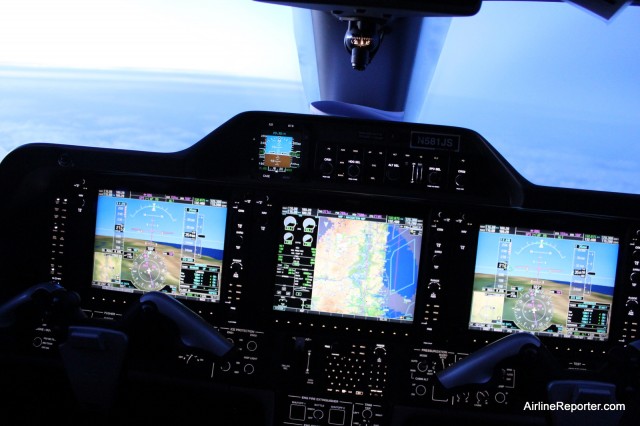
JetSuite opted to install Synthetic Vision on their Phenom 100's which give a realistic view of the terrain on the large screens.
Being able to work and collaborate with others is a huge benefit of taking an aircraft like this. Along for the ride was a photographer for AirlineReporter.com (thanks Amy), another journalist and Keith Rabin, the President of JetSuite. Although the engines were not that far away from us, there was not any trouble hearing and it was no problem getting work done. Four business people would not be able to hold a confidential meeting like this flying commercial, nor could four friends have such a grand time socializing.
Another benefit of riding your own private jet is that you can go check out the cockpit and take photos. When going up front, you are welcomed by three large screens. Each pilot can customize the look of his/her display. The photo above demonstrates the new Synthetic Vision which shows real time terrain behind everything else a pilot needs to know about their aircraft. Even though the Phenom 100 can be operated by just one pilot, JetSuite has chosen to use two.
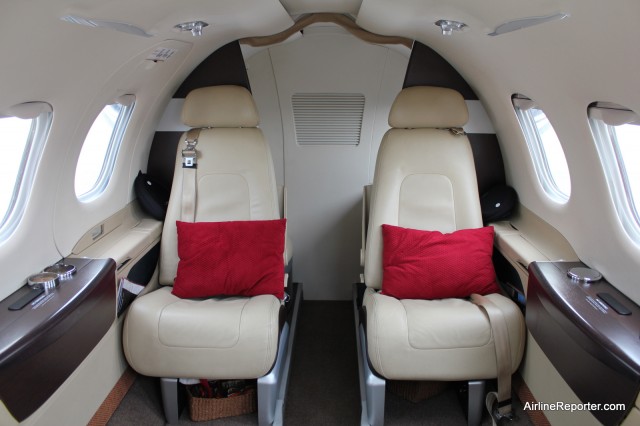
There is a small lavatory in the rear of the plane that requires a curtain. You might want to go before take off.
Even though the plane is small, there are quite a few amenities tucked in for the passengers. You have the ability to pull out some Bose headphones to either deaden the noise or listen to XFM Satellite radio. There was also hot coffee, cold drinks and a selection of snacks located in a bin right behind the seat. If one feels like having a few “adult beverages” there are plenty of choices (here is just one basket). Since my flight was early morning, I chose coffee and water.
There is a small lavatory in the back of the plane, which you need to put up a curtain to use. It is much better than having no restroom option, but I would suggest going before you take off or drink enough alcohol where you just won’t care anymore. You also are allowed to use your electronic devices whenever you want and if you are flying and get a cell signal, you are allowed to use it! Do not get too excited; I only had two short windows of cell reception to get Tweets out, but not being yelled at to put away my electronic devices was wonderful.
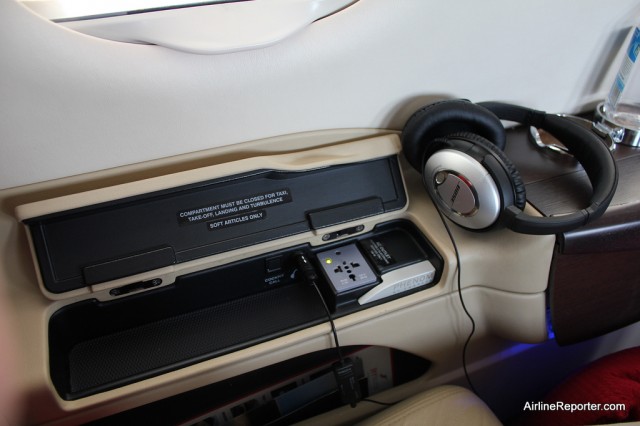
My seat had access to an outlet, Bose headphones to listen to XFM radio and a little storage area.
During the flight, I was able to learn about JetSuite and what they are are hoping to do in the future. The company was started in 2007 by JetBlue founder Alex Wilcox who knows airplanes. JetSuite currently operates a fleet of 13 Embraer Phenom 100s. They chose the aircraft because it provides some of the best economics for a private jet and is capable of providing quick short hop trips for their customers.
However, only being able to do short hops is detrimental for a company looking to expand. JetSuite wants to grow their operations, especially on the east coast and to reach Florida from the New York non-stop will require a larger aircraft. The obvious fit would be the Phenom 300 or if things are going well, maybe even the larger Embraer Legacy 500.
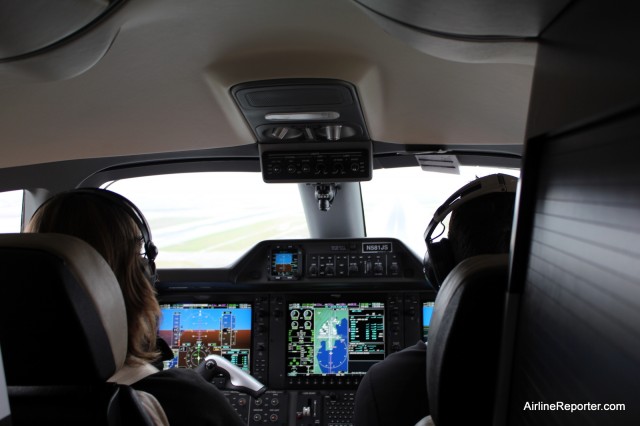
I was pretty upset that this photo did not turn out, but it was the best one I ended up with. I still want to share it since the experience was quite epic. We were on final approach into SFO and it is great to be able to turn around and watch out the cockpit window as we landed.
How does one go about getting a ride on JetSuite? Well, it depends on who you are and what you are looking for. On the crazy cheap end of things, you and three of your friends can take a flight one way for only $499 — about $125.00 per person. To get one of these deals, called “SuiteDeals”, you need to be very flexible and catch it on their Facebook page. When JetSuite has an empty leg, they will offer it and if a person has the ability to take them up on the offer, you have yourself one heck of a great deal.
If you are looking for something a bit more flexible, they also offer SuiteSavers from $1499 to $1999 each way. Of course they also offer getting a jet when and where you want it, but that will cost you a bit more — from $2500 to $4000 per hour depending on if you have a membership and your needs.
With some private jet companies, you have to invest for the long-term. Either buying a fraction of the plane or purchasing a costly hour card. But with JetSuite, there are no long term commitments or contracts. You want to fly once, you get to fly once — although a membership and multiple flights will bring down your costs per hour.
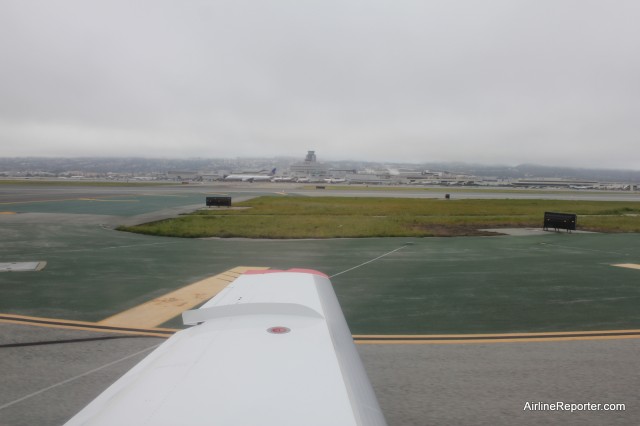
The wings on the Phenom 100 are tiny, but they get you where you need to go. Here we are landing at SFO.
JetSuite has recently started a business relationship with Singapore Airlines to allow passengers to maintain a high level of service that they have come to expect. Singapore Airlines is well known for their level of service (especially on their Airbus A380s) and although there might be a few US domestic airlines that provide a decent product, none are able to compete with Singapore’s first class suite.
The new relationship allows passengers to easily transfer from their Singapore Airlines flight to their JetSuite private aircraft. Once arriving, a car will pick you up and take you to JetSuite — really a suite-to-suite service.
Anyone who flies Singapore Airlines is able to get a discount, which depends on the type of class you are flying. If you are on a first class ticket, you will save up to $1400/hr and on a business class ticket up to $900/hr on your JetSuite flight.
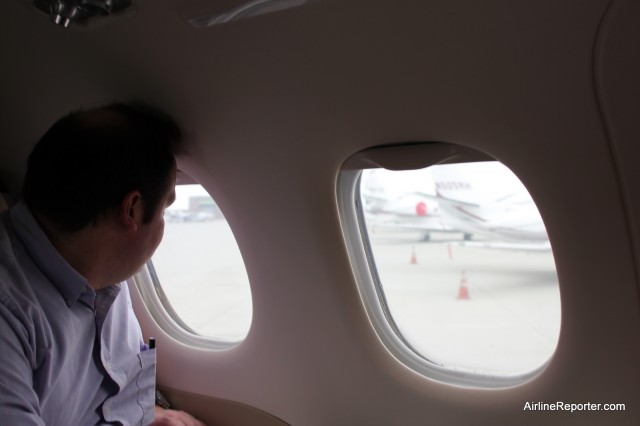
It was hard to leave the JetSuite Phenom 100. Especially knowing I had to fly back home commercial.
After spending a few hours in San Francisco touring Singapore Airline’s food facility (that story coming soon), it was to the “real” airport and time to board a Virgin America flight back to Seattle. Even though Virgin America might provide one heck of a domestic product, it just did not even come close to comparing to JetSuite. The problem with flying private jet, is it is hard to travel any other way in the future. I guess that is a problem I am willing to have.
I have been fortunate enough to experience many cool adventures with this blog, but almost none of them I could afford on my own. $8000.00 for a one way business class ticket? Ha! But this was an experience that I could actually afford, if I was able to get one of the last minute deals. Of course those of you with a bit more means at your disposal, even paying a full fare can be worth the time and hassle saved.
VIEW ALL 26 OF MY JETSUITE REVIEW PHOTOS
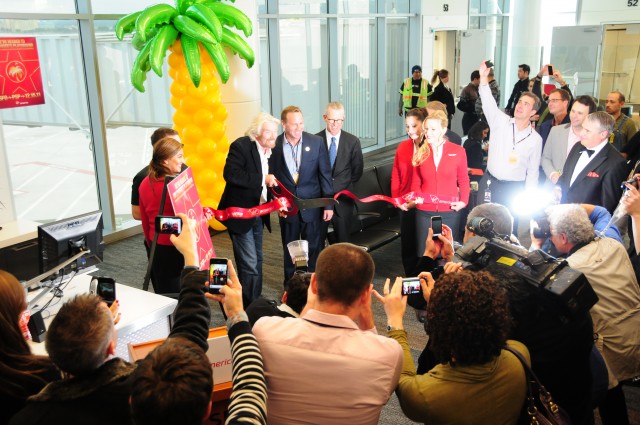
Celebrate Good Times! Sir Richard Branson and Palm Springs Mayor Steve Pougnethelps cut the ribbon at San Fransisco on December 15th. Photo by Nick Smith / AirlineReporter.com.
On December 15th, Virgin America celebrated their inaugural service to Palm Springs International Airport (PSP). The airline is offering daily non-stop flights from San Fransisco (SFO) and seasonal flights from John F Kennedy International Airport (JKF) with just one stop (in SFO), but no plane change required.
If you know Virgin America, they can’t just start a new route without some fun — this was no exception. AirlineReporter.com Correspondent Nick Smith was able to join in on the fun, starting in SFO, then taking the inaugural flight to PSP and a bit of fun while relaxing at the Riviera Palm Springs (note that the costs for the flight from Seattle to SFO to PSP and the hotel were taken care of by the airline and hotel).
“The Virgin terminal immediately turned into a party,” Nick explains. “Rat Pack impersonators set the tone of early fifties high class style that awaited down in Palm Springs. Crowds gravitated as Dean, Sammy and Frank occasionally broke into into a solo while holding martinis (which Virgin made available to everyone waiting to board).”
SFO’s new Terminal 2 had a party atmosphere and after a few short talks and a ceremonial ribbon cutting, it was time to board the plane; one of Virgin America’s stylish Airbus A320s (N623VA).
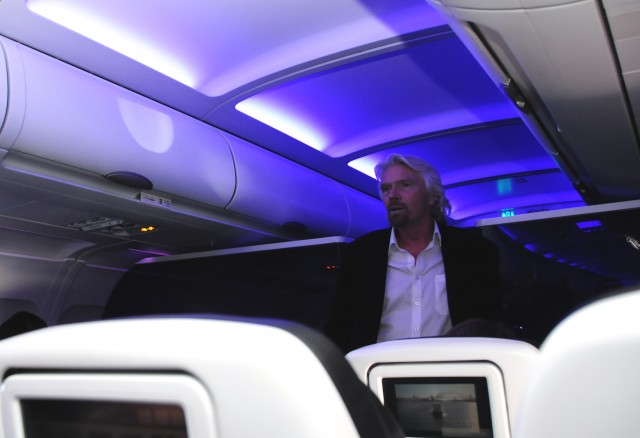
Sir Richard Branson walks down the aisle. Photo by Nick Smith / AirlineReporter.com.
Although the flight was short from SFO to PSP, there was still great adventure to be had. Drinks were on hand and Nick was able to hob-knob with David Cush, President and CEO of Virgin America and Sir Richard Branson.
“Sir Branson began his day in Australia but didn’t show any signs of fatigue,” Nick explained. “He made plenty of time for everyone’s questions and brought everyone’s spirit higher than the aircraft could have by itself. He clearly holds a lot of excitement for the new route and, like I, had never visited Palm Springs. ”
Special flights like these are always different. Most people are up and out of their seats and interacting with others. It is like a social shin-dig 30,000 feet up and this one was no different.
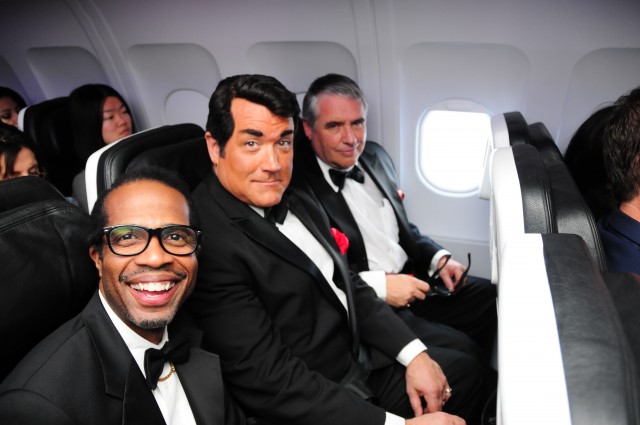
The Rat Pack on board the aircraft (at least people that look like them). Photo by Nick Smith / AirlineReporter.com.
“My favorite part of the flight was walking up and down the aisle talking to those who made this inaugural journey. Not a single passenger didn’t carry a smile and everyone had a story.”
Once the plane landed, it was welcomed by a water cannon salute and local media. There were lots of poses on the red carpet before Branson was whisked off in a helicopter (he is one busy dude) and other invited guests headed to the Riviera for some great food and drinks.
The feeling of the hotel really mirrors the energy from the surrounding area. “I asked Geoff Young, General Manager, a little about the history and style of this place, which encapsulates the spirit that made Palm Springs so popular in the heyday of early 1960’s Hollywood vacationing style,” Nick reported back. “He, as well as each member of the staff, showed absolute professionalism and commitment to service. It’s been a while since I actually felt special at a resort; this place did it.” This is about the time where I really start regretting sending Nick and wishing I was able to make the trip on my own — oh well.
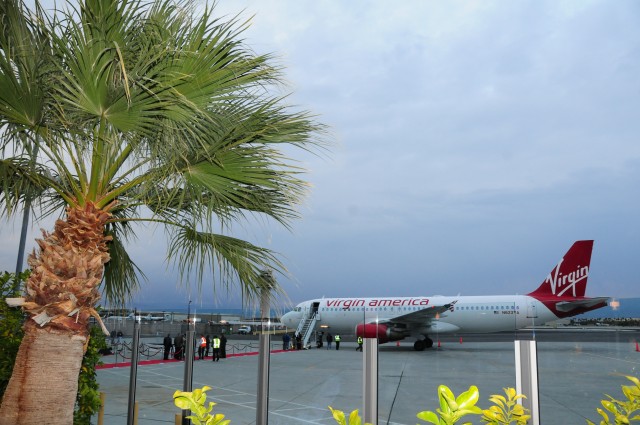
What would Palm Springs be without Palm trees? Photo by Nick Smith / AirlineReporter.com.
Palm Springs is the 16th desitnation that Virgin America flies to and it most likely won’t be the last. They have over 50 planes on order and big plans to continue growing. Although they hit a snag withing having to cancel their flight to Toronto and that pesky issue with not always making profit, they are still an airline that many in the business have started to watch closely. Palm Springs seems like a good fit for the airline and the city is excited to have them.
’œThe Virgin brand is a perfect fit with our destination,’ said Scott White, President and CEO of Palm Springs Desert Resorts CVA. ’œFrom our stylish hotels and resorts to our international festivals and 360 days of sunshine, the Virgin America guest will be able to find and experience their personal oasis! Virgin America’s new nonstop and through flights from SFO and JFK will also lower fares and improve service in our market, allowing more travelers to enjoy all that our unique region has to offer.’






















